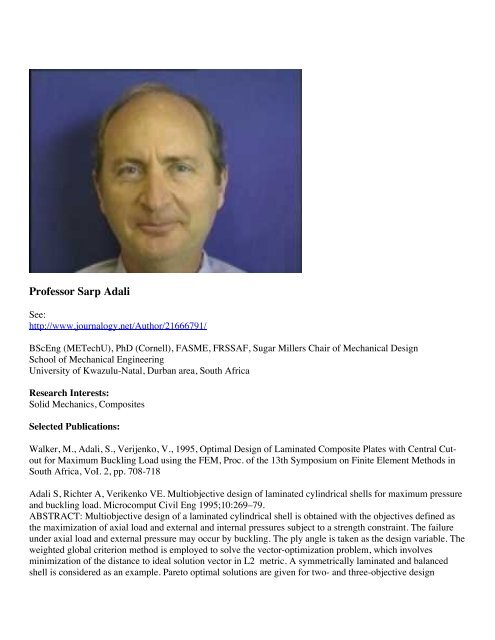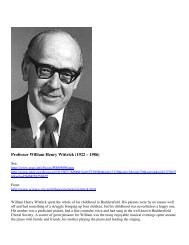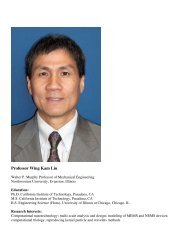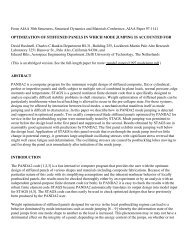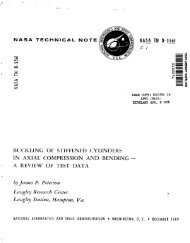Professor Sarp Adali - Shellbuckling.com
Professor Sarp Adali - Shellbuckling.com
Professor Sarp Adali - Shellbuckling.com
Create successful ePaper yourself
Turn your PDF publications into a flip-book with our unique Google optimized e-Paper software.
<strong>Professor</strong> <strong>Sarp</strong> <strong>Adali</strong><br />
See:<br />
http://www.journalogy.net/Author/21666791/<br />
BScEng (METechU), PhD (Cornell), FASME, FRSSAF, Sugar Millers Chair of Mechanical Design<br />
School of Mechanical Engineering<br />
University of Kwazulu-Natal, Durban area, South Africa<br />
Research Interests:<br />
Solid Mechanics, Composites<br />
Selected Publications:<br />
Walker, M., <strong>Adali</strong>, S., Verijenko, V., 1995, Optimal Design of Laminated Composite Plates with Central Cutout<br />
for Maximum Buckling Load using the FEM, Proc. of the 13th Symposium on Finite Element Methods in<br />
South Africa, VoI. 2, pp. 708-718<br />
<strong>Adali</strong> S, Richter A, Verikenko VE. Multiobjective design of laminated cylindrical shells for maximum pressure<br />
and buckling load. Micro<strong>com</strong>put Civil Eng 1995;10:269–79.<br />
ABSTRACT: Multiobjective design of a laminated cylindrical shell is obtained with the objectives defined as<br />
the maximization of axial load and external and internal pressures subject to a strength constraint. The failure<br />
under axial load and external pressure may occur by buckling. The ply angle is taken as the design variable. The<br />
weighted global criterion method is employed to solve the vector-optimization problem, which involves<br />
minimization of the distance to ideal solution vector in L2 metric. A symmetrically laminated and balanced<br />
shell is considered as an example. Pareto optimal solutions are given for two- and three-objective design
problems, and numerical results are presented in the form of tradeoff curves and surfaces. The effects of<br />
problem parameters are investigated, and the results are given for various weighting factors and shape<br />
parameters.<br />
Walker M, Reiss T, <strong>Adali</strong> S. Multiobjective design of laminated cylindrical shells for maximum torsional and<br />
axial buckling loads. Comput Struct 1997;62(2):237–42.<br />
ABSTRACT: The multiobjective design of a symmetrically laminated shell is obtained with the objectives<br />
defined as the maximization of the axial and torsional buckling loads. The ply angle is taken as the optimizing<br />
variable and the performance index is formulated as the weighted sum of individual objectives in order to obtain<br />
Pareto optimal solutions of the design problem. Single objective design results are obtained and <strong>com</strong>pared with<br />
the multiobjective design. The effect of weighting factors on the optimal design is investigated. Results are<br />
given illustrating the dependence of the optimal fibre angle and performance index on the cylinder length,<br />
radius and wall thickness.<br />
<strong>Adali</strong>, S. “Lay-up optimisation of laminated plates” in Buckling and Postbuckling of Composite Plates, eds.G.J.<br />
Turvey and I.H. Marshall, Chapman and Hall, 1996<br />
<strong>Adali</strong> S, Walker M, Verijenko VE. Multiobjective optimisation of laminated plates for maximum prebuckling,<br />
buckling and postbuckling strength using continuous and discrete ply angles. Compos Struct 1996;35:117–30.<br />
M. Walker, T. Reiss and S. <strong>Adali</strong> (Center for Engineering Research, Technikon Natal, Durban, South Africa),<br />
“Minimum weight design of <strong>com</strong>posite hybrid shells via symbolic <strong>com</strong>putation”, Journal of the Franklin<br />
Institute, Vol. 334, No. 1, January 1997, pp. 47-56, doi:10.1016/S0016-0032(96)00066-X<br />
ABSTRACT: The best layup for a hybrid laminated cylindrical shell subject to a buckling load constraint is<br />
determined. The objective of the optimisation is the minimum weight design of these structures. The ply angle<br />
is taken as the design variable. Various configurations of graphite and boron epoxy layers are considered in<br />
order to determine an optimal stacking sequence. The symbolic <strong>com</strong>putational software package<br />
MATHEMATICA is used in the implementation and solution of the problem. This approach simplifies the<br />
<strong>com</strong>putational procedure as well as the implementation of the analysis/optimisation routine. Results are given<br />
illustrating the dependence of the optimal layup on the cylinder length and radius. It is shown that a general<br />
purpose <strong>com</strong>puter algebra system like MATHEMATICA is well suited to solve structural design problems<br />
involving <strong>com</strong>posite materials.<br />
M. Walker, T. Reiss, S. <strong>Adali</strong>, P.M. Weaver, (1998) "Application of MATHEMATICA to the optimal design of<br />
<strong>com</strong>posite shells for improved buckling strength", Engineering Computations, Vol. 15 No. 2, pp.260 – 267<br />
doi: 10.1108/02644409810369248<br />
ABSTRACT: The optimal design of a laminated cylindrical shell is obtained with the objectives defined as the<br />
maximisation of the axial and torsional buckling loads. The ply angle is taken as the design variable. The<br />
symbolic <strong>com</strong>putational software package MATHEMATICA is used in the implementation and solution of the<br />
problem. This approach simplifies the <strong>com</strong>putational procedure as well as the implementation of the<br />
analysis/optimisation routine. Results are given illustrating the dependence of the optimal fiber angle on the<br />
cylinder length and radius. It is shown that a general purpose <strong>com</strong>puter algebra system like MATHEMATICA<br />
is well suited to solve small boundary value problems such as structural design optimisation involving
<strong>com</strong>posite materials.<br />
<strong>Sarp</strong> <strong>Adali</strong> (1), Viktor E. Verijenko (1) and Alexander Richter (2)<br />
(1) Department of Mechanical Engineering, Centre for Composite Materials and Structures, University of Natal,<br />
Durban 4041, South Africa<br />
(2) Command Audio Corporation, 101 Redwood Shores Parkway, Redwood City, CA 94065, USA<br />
“Minimum sensitivity design of laminated shells under axial load and external pressure”, Composite Structures,<br />
Vol. 54, Nos. 2-3, November-December 2001, pp. 139-142, doi:10.1016/S0263-8223(01)00081-2<br />
ABSTRACT: A laminated cylindrical shell of finite length under <strong>com</strong>bined loads is optimized for minimum<br />
sensitivity of buckling load to variations in ply angles subject to a constraint on buckling load. The design<br />
variable is taken as the fiber orientation of individual layers. The general theory of laminated plates is employed<br />
to determine the buckling loads. The formulation includes the contribution of the shear deformation and the<br />
variation of the radius over the thickness of the shell. Numerical results are given for both thin and thick shells.<br />
The results are given for various values of the external pressure and different shell aspect ratios. It is shown that<br />
the minimum sensitivity design depends on the constraint on buckling load.<br />
<strong>Sarp</strong> <strong>Adali</strong> (University of Natal, Durban, South Africa), “Optimization of laminated <strong>com</strong>posites and overview<br />
of smart material applications”, in Modern trends in <strong>com</strong>posite laminates mechanics, edited by Holm Altenbach<br />
and Wilfried Becker, CISM Courses and Lectures No. 448, International Center for Mechanical Sciences,<br />
Springer, 2003, ISBN 3-211-20302-8<br />
ABSTRACT: The issues, problems and techniques concerning the optimization of laminated <strong>com</strong>posites are<br />
discussed and specific cases of design optimization are presented. After a general introduction to methods of<br />
optimization of <strong>com</strong>posites with emphasis on genetic algorithms, a discussion of design and decision variables<br />
is given and problem <strong>com</strong>plexities are highlighted. This is followed by specific examples of <strong>com</strong>posites design<br />
under deterministic conditions, and in particular, stiffness and strength optimization, thermal buckling, and<br />
optimization with mujltiple objectives are studied. The design uncertainties are the subject of the separate<br />
chapter where design optimization techniques such as convex modeling and anti-optimization are illustrated<br />
again by means of specific examples involving uncertain material, load and geometric data. Secion 6 provides<br />
an overview of the properties and applications of widely used smart materials which is followed by some<br />
specific examples of the use of smart materials in vibration control and <strong>com</strong>posite design applications. It is<br />
noted that sections 1-5 (except the material on genetic algorithms) are an abridged version of the material in<br />
<strong>Adali</strong> (2003) which is being published in these Lecture Notes with the permission of CRC Press.<br />
<strong>Adali</strong>, S., Lene, F., Duvaut, G. and Chiaruttini, V. "Optimization of laminated <strong>com</strong>posites subject to uncertain<br />
buckling loads". Composite Structures, Vol. 62, No. 3-4, pp 261-69, 2003.<br />
Izzet U. Cagdas and <strong>Sarp</strong> <strong>Adali</strong>, “Buckling of cross-ply cylinders under hydrostatic pressure considering<br />
pressure stiffness”, Ocean Engineering, Vol. 38, No. 4, pp. 559-569, 2011,<br />
DOI: 10.1016/j.oceaneng.2010.12.005<br />
ABSTRACT: Buckling behavior of cross-ply cylinders under hydrostatic pressure is investigated using a semianalytical<br />
finite element based on a consistent first order shear deformable shell theory. Potential loss due to<br />
external pressure, also called pressure stiffness (PS) is taken into account by making use of Koiter's related<br />
energy expression. A number of verification problems are solved and the numerical results are <strong>com</strong>pared with<br />
the analytical results available in the literature and excellent agreement is observed. New numerical results are
presented to assess the effect of PS on buckling due to hydrostatic pressure. It is shown that PS causes a<br />
decrease in the buckling load and this decrease depends on the size of the cylinder and the material. Also, issues<br />
related to thickness optimization are examined and optimal lamina thicknesses are determined for a number of<br />
cases with and without PS taken into account.<br />
Izzet U. Cagdas and <strong>Sarp</strong> <strong>Adali</strong>, “Effect of in-plane boundary restraints on optimal design of skew laminates<br />
under buckling loads”, Composite Structures, Vol. 93, No. 8, pp. 2060-2069, 2011,<br />
DOI: 10.1016/j.<strong>com</strong>pstruct.2011.02.015<br />
ABSTRACT: Symmetrically laminated cross-ply and angle-ply skew plates subject to uniaxial buckling loads<br />
and various <strong>com</strong>binations of in-plane boundary restraints are studied using a shear deformable theory. For this<br />
purpose a finite element code is developed and applied to a couple of verification problems. The formulation of<br />
the parabolic iso-parametric plate element is briefly given and numerical results obtained for the verification<br />
problems related to stability analysis and stress diffusion are presented. The effect of in-plane restraints on the<br />
non-uniform distribution of in-plane stresses is studied by means of contour graphs. Next the buckling loads are<br />
maximized with respect to layer thicknesses in the case of cross-ply laminates and with respect to fiber<br />
orientations in the case of angle-ply laminates. The optimization results show that the exclusion of the in-plane<br />
restraints, which arise in several engineering applications, may lead to errors in the stability analysis and<br />
consequently in the design of laminated plates against buckling.<br />
S. <strong>Adali</strong> and Izzet U. Cagdas, “Failure analysis of curved <strong>com</strong>posite panels based on first-ply and buckling<br />
failures”, Procedia Engineering , vol. 10, pp. 1595-1600, 2011, DOI: 10.1016/j.proeng.2011.04.266<br />
ABSTRACT: Curved panels are used extensively in several branches of engineering and in particular in marine<br />
and aerospace engineering working mostly under <strong>com</strong>pressive loads. Failure of these <strong>com</strong>ponents by buckling<br />
or excessive stress is an important design consideration. In the present study the effect of fiber orientation is<br />
studied on the failure load of a laminated curved panel subject to uniaxial <strong>com</strong>pression. The failure modes are<br />
specified as first-ply failure and buckling with the failure load defined as the minimum of these two loads. The<br />
panel is taken as a symmetrically laminated angle-ply plate and the failure load is determined for different<br />
aspect ratios, panel thicknesses and boundary conditions (simply supported and clamped panels). The failure<br />
load is maximized for a set of selected stacking sequences by determining the best ply angle for each stacking<br />
sequence giving the highest failure load.


